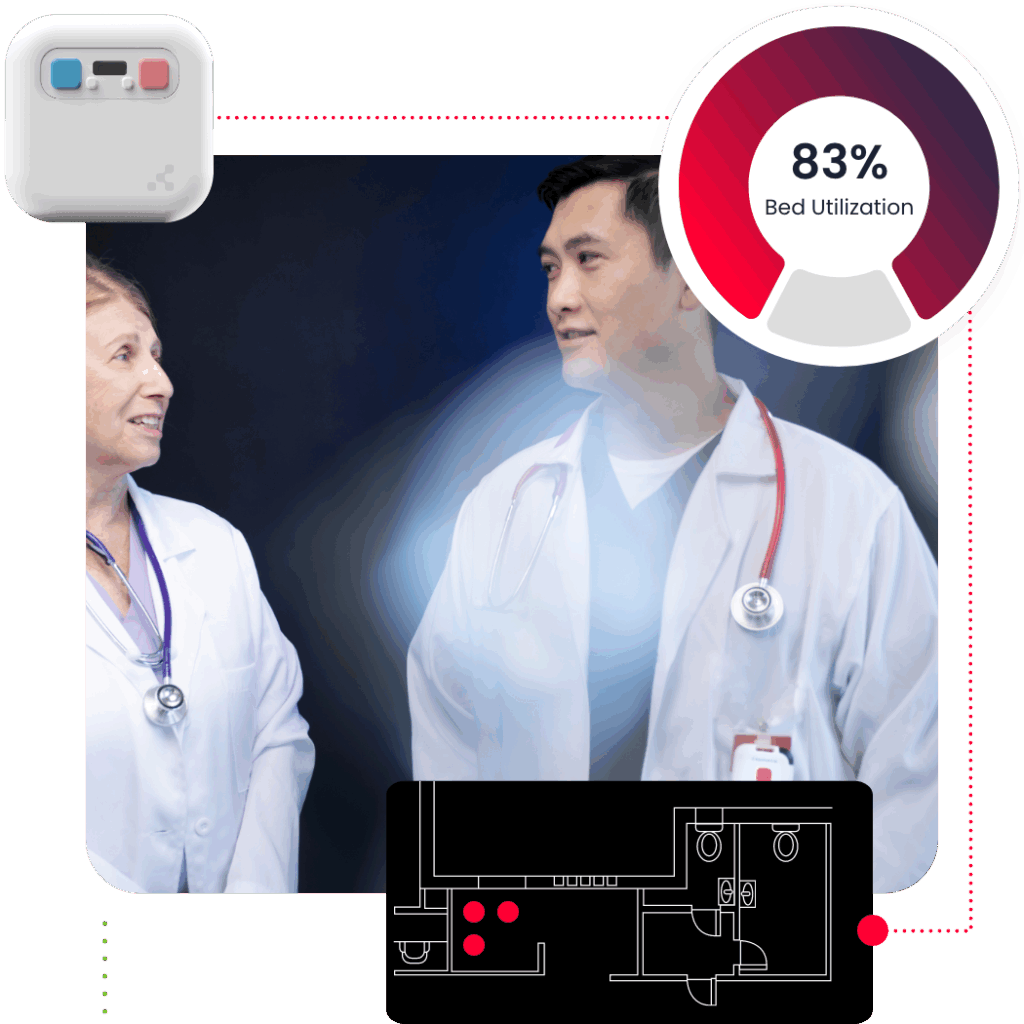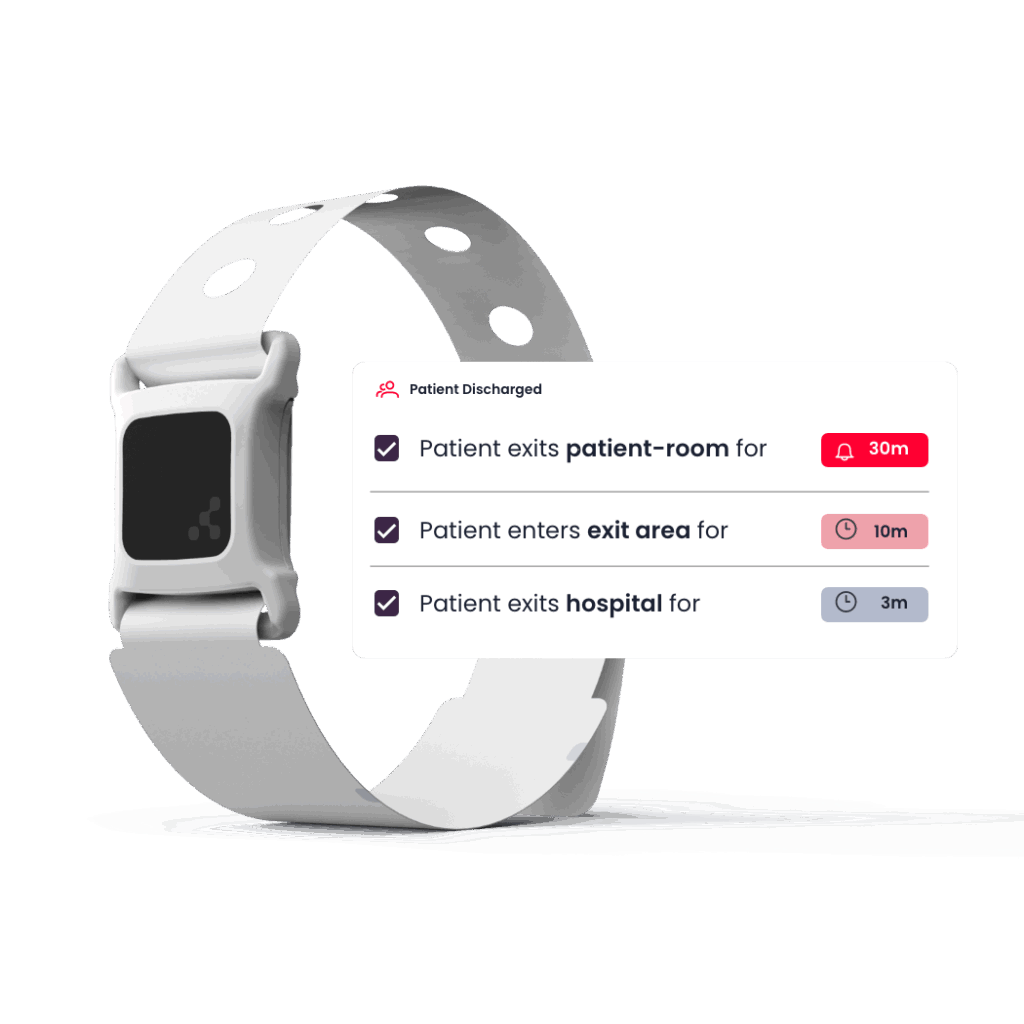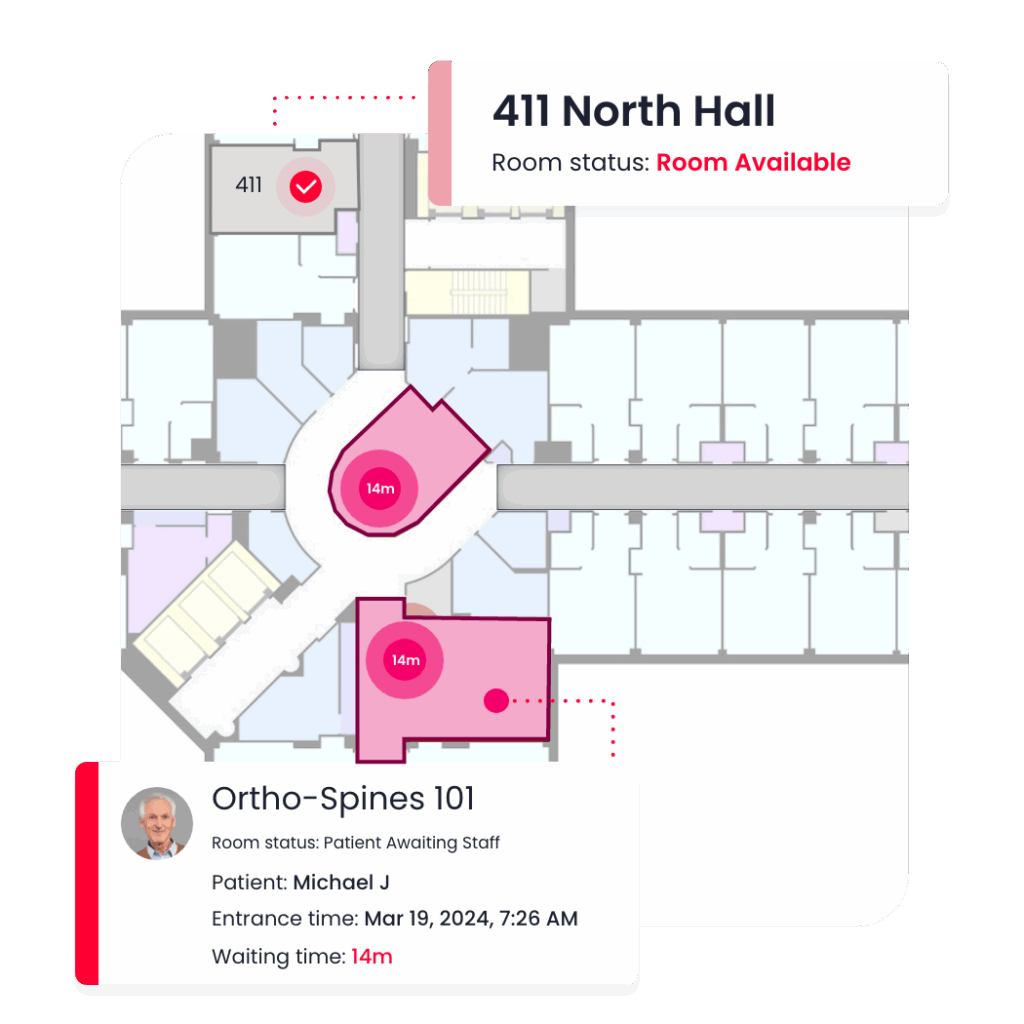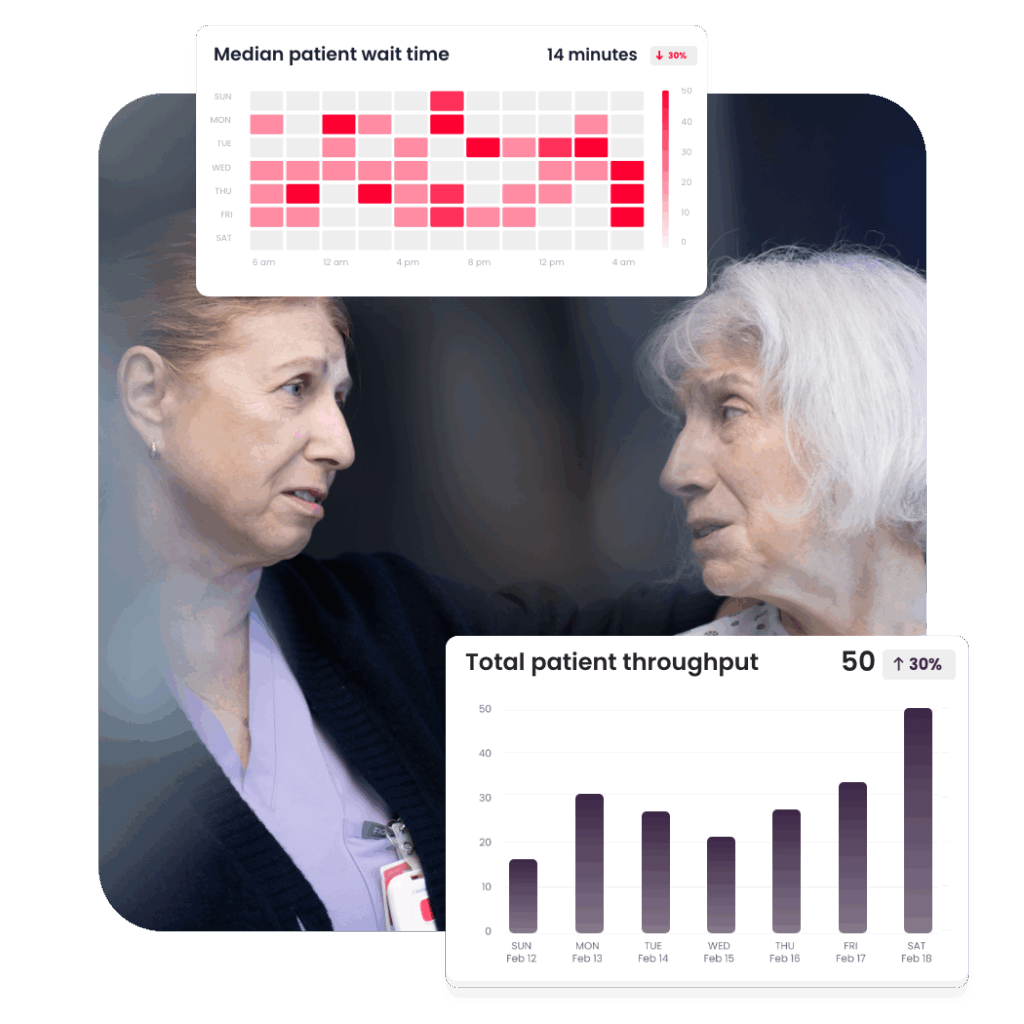At first glance, hospital bed tracking sounds like a simple, straightforward task. But if you operate a large medical center or a chain of hospitals, you likely know that there is more to bed tracking than meets the eye. Poor bed visibility, deferred bed maintenance, and a lack of centralized information can all make it difficult to keep track of available beds. Below is a look at some top bed-related challenges facing today’s hospitals and the specific ways a real-time hospital bed management solution can prime your hospital for success.
What Is Bed Management in Hospitals?
Bed management in hospitals refers to the process of efficiently allocating and tracking hospital beds to ensure the smooth flow of patients throughout their care journey. It connects the operational and clinical sides of healthcare — coordinating admissions, discharges, cleaning, and maintenance so that every patient has access to an appropriate bed when they need it. In practice, this means monitoring bed occupancy, predicting upcoming discharges, and aligning resources across departments.
When bed management works well, patients move seamlessly from the emergency department to the ward, from surgery to recovery, and from inpatient care to discharge — all without unnecessary waiting or confusion. However, when it breaks down, the entire patient flow process is disrupted. Delays in bed turnover or inaccurate bed availability information can cause backups in emergency departments, postponed surgeries, and a decline in overall patient satisfaction.

Why Hospital Bed Management Is Key to Successful Patient Flow
At first glance, hospital bed tracking may sound like a logistical issue — but it’s really a patient flow challenge at its core. Every bed that’s unavailable, misplaced, or waiting to be cleaned represents a delay in care for someone else waiting to be admitted.
Hospitals that optimize bed management can significantly reduce patient wait times, improve staff coordination, and make better use of their existing capacity — without necessarily expanding infrastructure. By integrating BLE-based hospital bed management software, they can see exactly where bottlenecks occur and address them in real time.
What are the top benefits of hospital bed management system?
A well-designed hospital bed management system gives hospitals a unified way to monitor, manage, and optimize bed-related workflows. When powered by RTLS and BLE (e.g. BLE beacons), it enables real-time visibility, automation, and analytics — helping to break down operational silos and speed up patient flow.
Benefits of a Hospital Bed Management System for Clinicians
Improved Patient Flow
Smooth patient flow is one of the biggest challenges for clinical teams. When beds aren’t freed or assigned promptly, patients back up in the emergency department, care delivery slows, and discharge plans stall. A hospital bed management system helps clinicians manage admissions, transfers, and discharges in real time — ensuring that patients move efficiently through every stage of care.
It automatically detects when a patient has left a room and notifies environmental services teams immediately, so cleaning can begin without delay. With BLE tags, the system provides real-time visibility into patient movement, detecting with confidence when a bed is free and ready for turnover.
The result is faster discharge-to-admission cycles, less downtime, and a continuous flow of patients through the hospital — without manual intervention.

Enhanced Visibility and Decision-Making
Clinicians rely on accurate, up-to-date information to make quick, confident decisions. Without centralized visibility, they often waste valuable time confirming bed status, searching for open rooms, or waiting for updates from other units. Modern hospital bed management software solves this by providing a live operational view of patient and bed status across the hospital.
Teams can track each patient’s journey from admission to discharge using BLE-connected tags that integrate seamlessly with wristbands or patient badges. From a single dashboard, clinicians can access:
- A live map of all beds and patient locations
- Room occupancy data and wait times
- Information on which clinicians or staff are in each room
They can even filter data by department, staff type, or patient group to pinpoint where delays or congestion are happening. This live situational awareness enables more effective decision-making, faster handoffs, and better prioritization of care.

Streamlined Communication Across Departments
Communication breakdowns are a leading cause of inefficiency in hospitals. When discharge, cleaning, and admission teams work from different systems — or rely on phone calls and messages — information gaps quickly lead to bottlenecks. A connected bed management system brings every department onto a shared, real-time platform.
As soon as a patient is discharged, environmental services are notified automatically; when cleaning is complete, the next clinical team receives an instant alert that the bed is ready. This reduces unnecessary calls, avoids duplicate updates, and ensures everyone — from nursing to housekeeping — has access to the same live data. The result is faster collaboration, fewer misunderstandings, and a smoother patient handoff between care teams.
Reduced Administrative Burden and Errors
For clinicians, manual administrative tasks are more than a nuisance — they take time away from patient care and increase the risk of mistakes. Updating spreadsheets, calling departments for bed status, or reconciling conflicting reports all create room for error and inefficiency. An automated bed management solution removes these friction points.
Because BLE-enabled tags continuously update bed and patient information in the background, there’s no need for manual tracking or redundant data entry. Dashboards refresh automatically, showing real-time bed status, occupancy, and patient movement without requiring user input. This not only saves time but also minimizes data errors — ensuring that clinical decisions are always based on accurate, current information.

Better Patient Outcomes and Experience
Every operational improvement ultimately benefits patients. When beds are available faster, discharges happen on time, and transfers occur seamlessly, patients spend less time waiting and more time receiving care.
Advanced AI analytics further enhance this by helping hospitals optimize patient flow proactively. By analyzing trends in patient throughput, wait times, and peak hours, hospitals can better align resources with demand — ensuring that clinical teams have the staff and space they need exactly when they need it.

Benefits of a Hospital Bed Management System for Patients
Shorter Wait Times and Faster Admissions
From a patient’s perspective, waiting for a bed is one of the most frustrating parts of a hospital visit. Real-time visibility ensures open beds are identified and prepared immediately, reducing wait times in the emergency department or after surgery. Patients move into appropriate rooms faster, and staff can focus on providing care instead of searching for space.
Smoother Transfers Between Units
Efficient bed management supports every step of the patient journey — from emergency to inpatient care, surgery to recovery, or ICU to discharge. By eliminating bottlenecks, hospitals ensure that transfers happen without unnecessary delay, maintaining both patient safety and comfort.
Fewer Canceled or Delayed Procedures
Cancellations often occur when postoperative or intensive-care beds aren’t available at the right time. An intelligent hospital bed management system keeps everyone aware of real-time capacity, ensuring that surgical schedules proceed as planned. This reduces disruptions, helps maintain trust, and preserves revenue.

A More Predictable and Transparent Experience
Automation and data sharing make hospital operations more predictable — for both staff and patients.
Fewer delays, smoother transitions, and reliable communication all contribute to a sense of order and professionalism that patients immediately notice.
Improved Overall Satisfaction
When patients spend less time waiting and receive care without unnecessary delays, their perception of quality increases. Hospitals that invest in bed management systems typically see measurable improvements in satisfaction surveys and care outcomes — not because of technology alone, but because processes finally align around the patient.
Hospital bed tracking – key challenges
The path to improved hospital bed management systems begins with an understanding of the barriers facing today’s hospitals. Here is a look at some of the key challenge that negatively impact a hospital’s HCAHPS rating and revenue:
1) Bottlenecks in patient flow
“A bottleneck is the part of the patient care journey that cannot meet the demand for services efficiently. At this point, services are delayed and patient care must wait.” – Patrice Spath, RHIT, Adjunct Professor University of Alabama at Birmingham.
Bottlenecks in patient flow top the list of barriers to an efficient hospital bed tracking system because they directly impact the patient experience and hospital profitability. They occur when demand for beds or a particular hospital service exceeds the hospital’s available resources. If they are not addressed, bottlenecks can negatively impact the entire patient care experience.
2) Poor bed visibility
Not being able to accurately know how many beds are available tremendously affects hospital bed management. Hospitals that lack real-time visibility of available beds are left to use outdated information to guess how many beds are available in each department. Underestimating that number can cause patients to wait as open beds remain unoccupied. And overestimating the number of available beds can lead to frustration as patients are transported to beds that are already filled.
3) Defective beds
No piece of hospital equipment is immune to problems. But when a hospital bed breaks down, the consequences are especially costly because a patient room remains unoccupied until the bed is repaired or replaced. Common reasons for defects include worn parts, operational errors, and lapses in preventive maintenance.

4) Canceled surgeries
“Cancelling operations is not a decision we ever take lightly…We cannot operate on patients if we have nowhere to care for them. We cancelled these cancer operations predominantly due to the lack of a bed in intensive care.” – John Adler, Leicester NHS Trust Chief Executive.
5) Missing and stolen beds
In 2019, Florida VA Hospitals reported nearly $5 million in missing medical equipment. The list of missing and stolen items included a wide range of items ranging from computers to a $25,000 eye scanner. With new FDA-approved electric hospital beds costing over $10,000 and most professionally refurbished hospital beds costing over $2,000, hospitals cannot afford to lose beds to theft or misplacement. That’s why hospital bed tracking is a must.
6) Sluggish cash flow
Poor patient flow, canceled surgeries, and a lack of preventive maintenance combine to create a recipe for sluggish cash flow for hospitals. And when hospitals fail to meet revenue goals, they are unable to expand services or invest in new technology. A hospital bed management system is then unable to maintain its competitive edge.
How does a BLE-based bed management software work?
A BLE-based hospital bed management system connects beds, patients, and staff through small Bluetooth® Low Energy (BLE) beacons and a Real-Time Location System (RTLS) network. Each tagged bed continuously emits a signal that nearby gateways detect and send to a secure cloud platform. The system processes this data to determine each bed’s exact location and status — occupied, being cleaned, ready, or under maintenance — and updates it in real time across hospital dashboards and apps.
From a user’s perspective, everything happens automatically in the background. When a patient is discharged, the platform detects the bed’s movement, updates its status, and notifies environmental services that it’s ready for cleaning. Once complete, the bed becomes instantly available for the next admission. Clinicians can access a live map showing all bed locations, occupancy levels, and patient journeys — including who’s in each room and where delays are forming — without needing to make calls or manual updates.
- Integrate: Attach BLE tags to beds and connect RTLS gateways to existing hospital networks.
- Detect: BLE signals update the bed’s location and movement in real time.
- Analyze: The platform processes data and syncs it with EHR and facility systems.
- Act: Automated alerts notify cleaning, maintenance, or admissions teams instantly.
- Optimize: AI analytics surface trends in bed use, wait times, and patient flow for continuous improvement.
By combining automation, live monitoring, and data analytics, BLE-based bed management software transforms everyday hospital operations into a connected, intelligent workflow that supports faster decisions and smoother patient care.
What is the best way to improve your hospital bed management?
As outlined above, a real-time management solution using BLE Beacons and RTLS can help you overcome some of the greatest challenges facing today’s hospitals. The single best step to improving your hospital bed management system is to schedule a discovery call with a Kontakt.io specialist. During your complimentary discovery call, you will learn how Kontakt.io’s solutions can help you achieve the following at your hospital:
- Increased bed visibility
- Improved predictive maintenance
- Enhanced patient safety
- Superior management of bed inventory

Frequently Asked Questions
Join 200k+ Caregivers utilizing our solutions in hundreds of hospitals — from the nation’s largest networks to regional leaders.
A hospital bed management system is a digital solution that tracks and manages hospital beds across multiple departments in real time. It gives administrators and staff instant visibility into bed occupancy, maintenance status, and location. By replacing manual tracking with automated data, hospitals can streamline patient admissions, optimize space utilization, and prevent bottlenecks. Modern systems like BLE-based solutions combine IoT sensors and software analytics to create an accurate, real-time map of available beds, helping operations teams make faster, data-driven decisions and improve hospital throughput
Hospital operations depend on efficiency, communication, and timely patient flow. A hospital bed management system centralizes real-time bed information, allowing teams to coordinate admissions, transfers, and discharges more effectively. By automating visibility into bed status and location, hospitals reduce delays, improve turnover times, and make better use of available resources. Operational leaders also gain valuable analytics on usage patterns, maintenance cycles, and occupancy rates — all of which support data-driven decisions, enhance staffing efficiency, and ultimately improve financial performance across the organization.
Real-time bed tracking directly addresses one of the biggest challenges in hospital operations: patient flow bottlenecks. With a digital tracking system, staff can instantly see which beds are available, occupied, or pending cleaning. This eliminates manual communication gaps that often delay admissions and discharges. Automated alerts and dashboards ensure that environmental services, bed managers, and nursing units stay aligned. As a result, patients move through care stages faster, waiting times drop, and the entire hospital network functions more smoothly — a measurable boost to both efficiency and patient satisfaction.
Hospitals that rely on manual or outdated tracking methods face several operational risks. Poor bed visibility leads to delays in patient admission, overestimation of capacity, and underutilized resources. Beds awaiting maintenance or cleaning may remain unavailable longer than necessary. Missing or misplaced beds result in wasted staff time and higher replacement costs. These inefficiencies often cascade into canceled surgeries, longer wait times, and revenue loss. Without a centralized hospital bed management system, administrators lack the real-time insights needed to manage capacity, improve patient flow, and maintain consistent operational performance.
BLE-based hospital bed management software uses Bluetooth Low Energy (BLE) technology to provide real-time location and status data for every bed in a facility. By attaching BLE tags to beds, hospitals gain a live digital map of where each asset is and whether it’s in use, idle, or in maintenance. This enhanced visibility enables smarter utilization — freeing up beds faster, reducing idle time, and avoiding double-booking. BLE solutions also integrate seamlessly with existing hospital systems, helping operational teams respond faster, plan better, and reduce inefficiencies across departments.
Canceled surgeries often stem from poor bed availability or communication breakdowns between departments. A hospital bed management system solves this by ensuring surgical and recovery units always have real-time information about bed status. When postoperative beds are visible and reserved in advance, scheduling teams can proceed confidently without risking last-minute cancellations. This not only reduces financial losses but also enhances staff coordination and patient satisfaction. By improving bed visibility, hospitals strengthen their operational reliability — a critical factor for maintaining both efficiency and reputation.
IoT-enabled bed tracking systems give hospitals a powerful defense against misplaced or stolen assets. BLE or RFID tags attached to beds continuously transmit their location to a central dashboard, showing exactly where each bed is at any moment. If a bed moves outside a designated zone, automated alerts notify staff instantly. Over time, tracking data reveals movement patterns that help identify misuse or inefficiency. Beyond preventing theft, this visibility also streamlines asset audits and improves accountability — saving hospitals significant time, money, and administrative effort.
When evaluating a hospital bed management system, look for features that enhance both visibility and operational decision-making. Key capabilities include real-time bed tracking, automated status updates, preventive maintenance alerts, and analytics dashboards that visualize occupancy trends. Integration with existing hospital information systems (HIS) and facility management tools is also crucial for seamless workflows. A modern solution should leverage IoT or BLE technology, support zone-based alerts, and offer flexible reporting for administrators. Together, these features help hospitals achieve higher efficiency, reduce costs, and improve patient throughput.
By automating bed tracking and communication, a hospital bed management system frees staff from time-consuming manual coordination. Bed managers no longer need to call multiple departments to confirm availability — they can access accurate, real-time data instantly. This allows clinical and operational teams to focus more on patient care and less on logistics. Faster bed assignments reduce patient waiting times and improve satisfaction scores. Ultimately, staff efficiency and patient experience are closely linked — and digital bed management bridges the gap between operational excellence and quality care.
Preventive bed maintenance is essential to keeping hospital operations smooth and financially healthy. A proactive maintenance schedule ensures that beds remain functional, safe, and compliant, minimizing unexpected breakdowns that can leave rooms unoccupied. With digital tracking and automated alerts, hospitals can monitor maintenance intervals, service history, and performance trends. This reduces downtime, prevents costly repairs, and supports a consistent patient flow. By integrating preventive maintenance into the hospital bed management system, administrators not only extend asset lifespan but also protect revenue and operational reliability